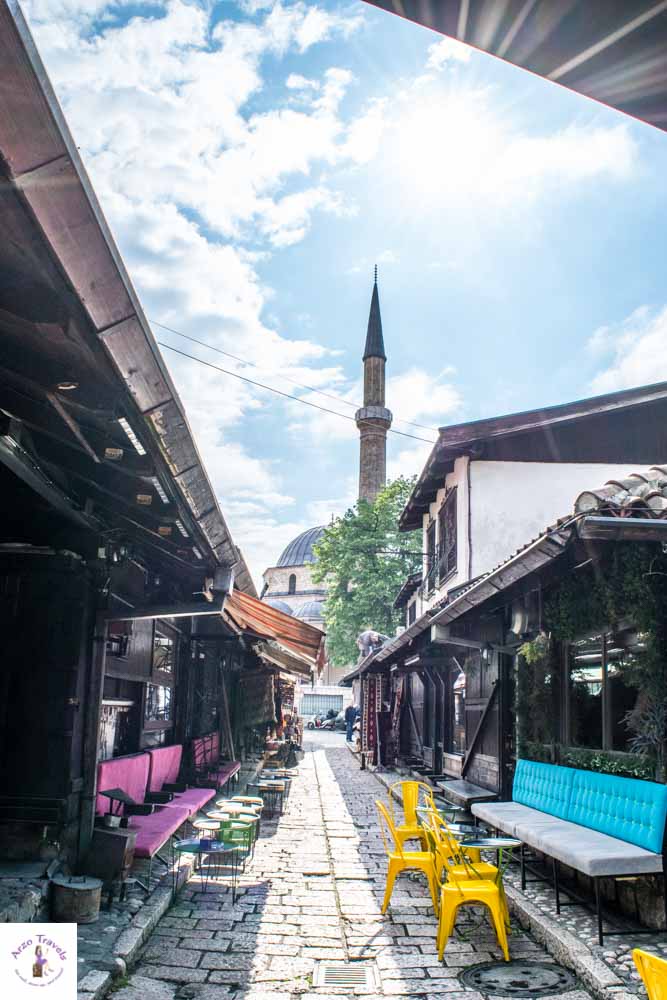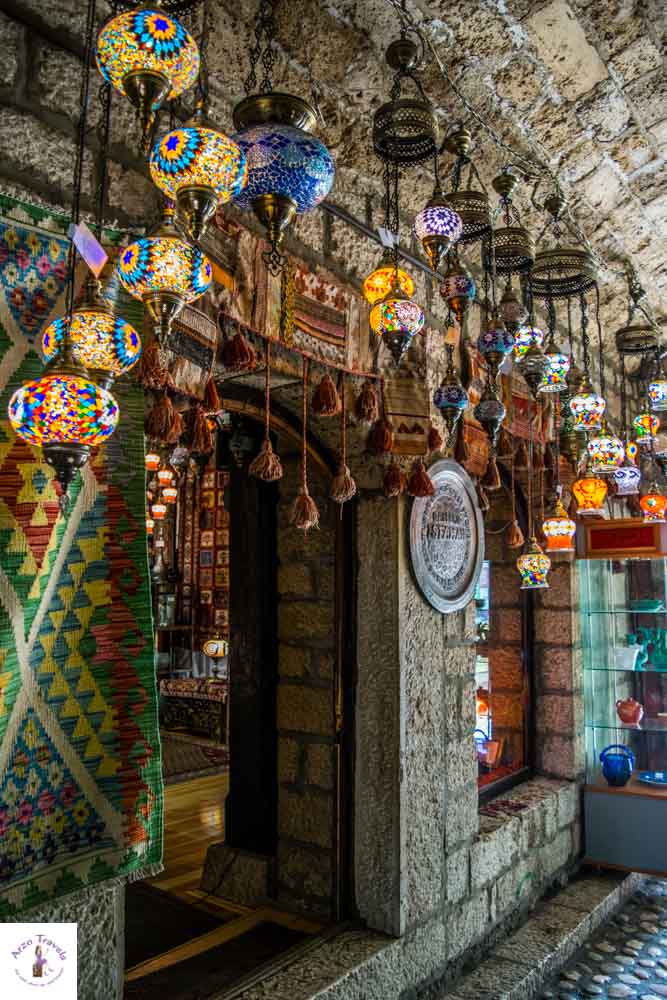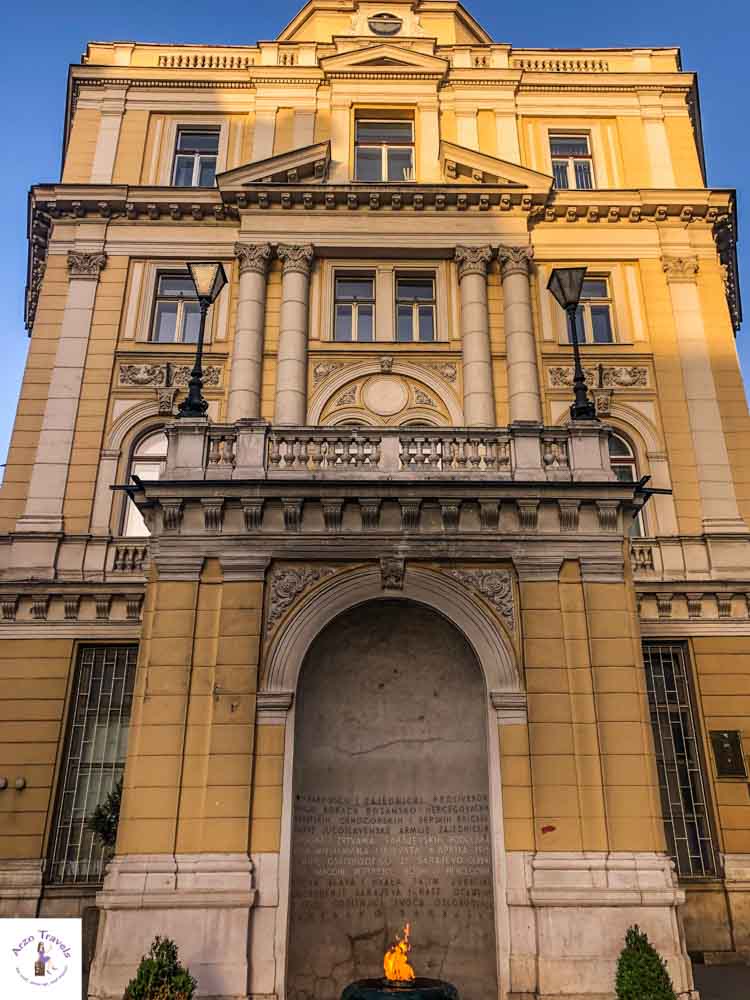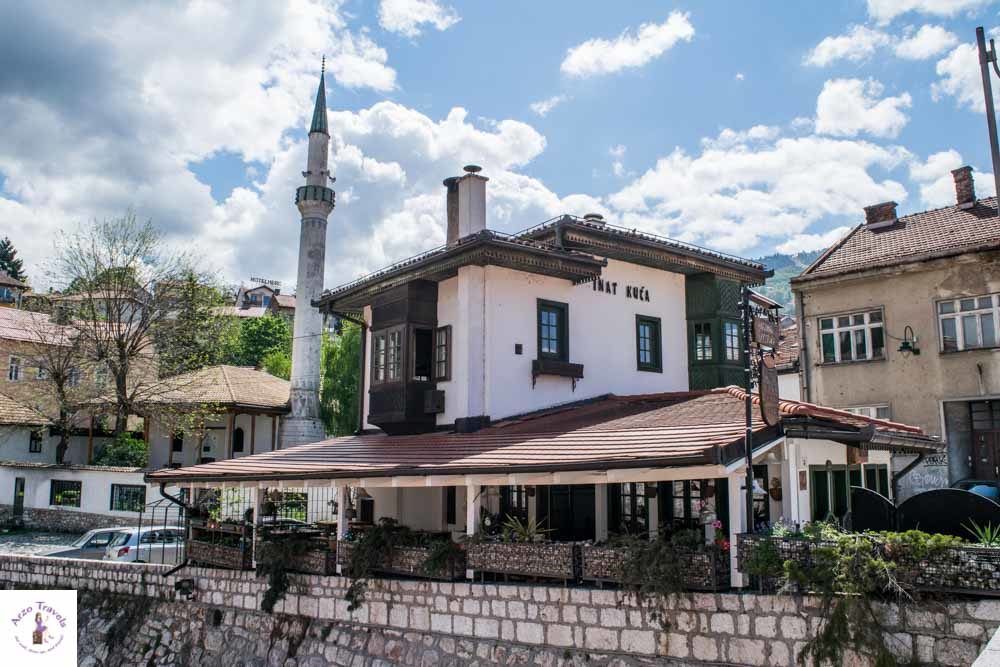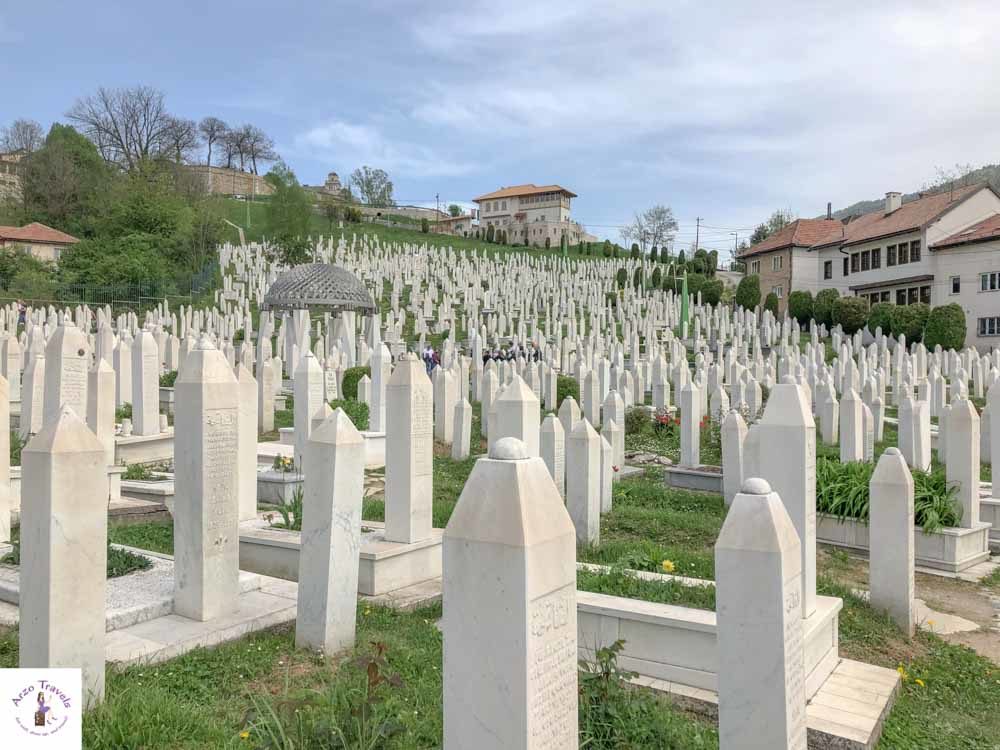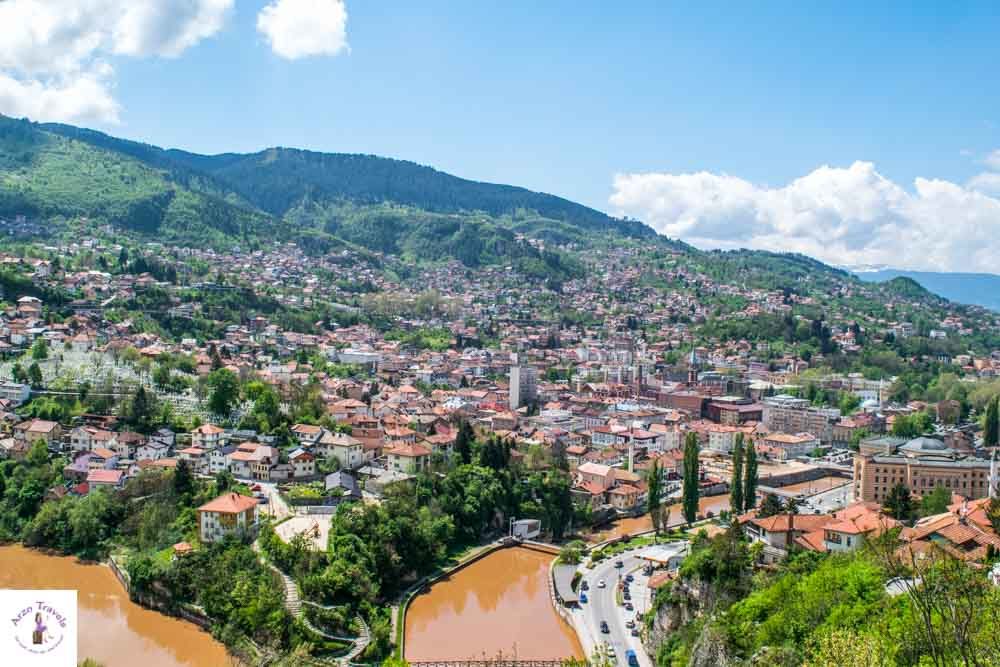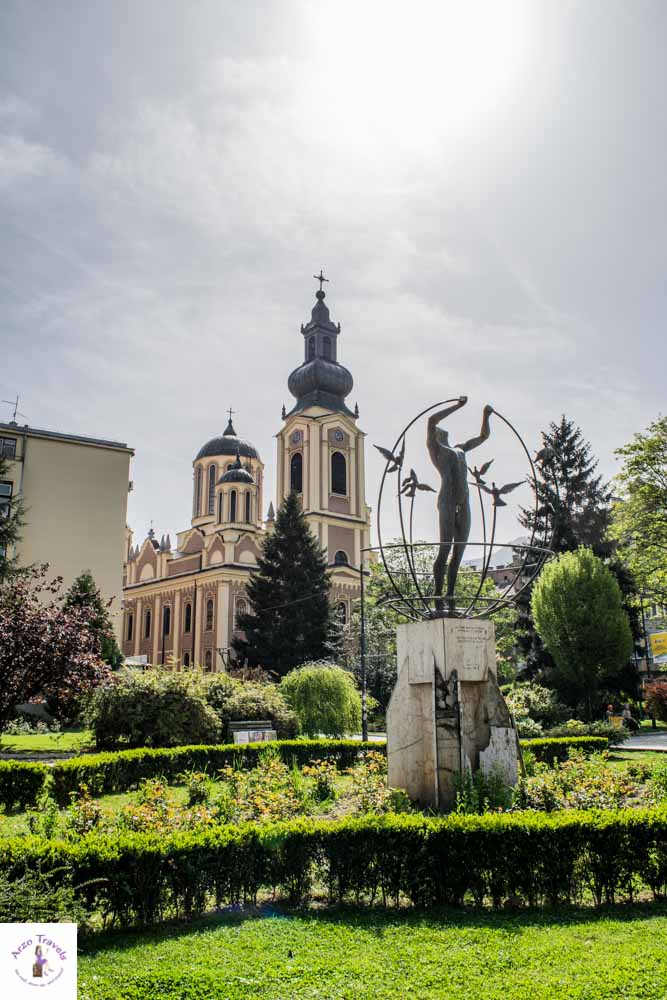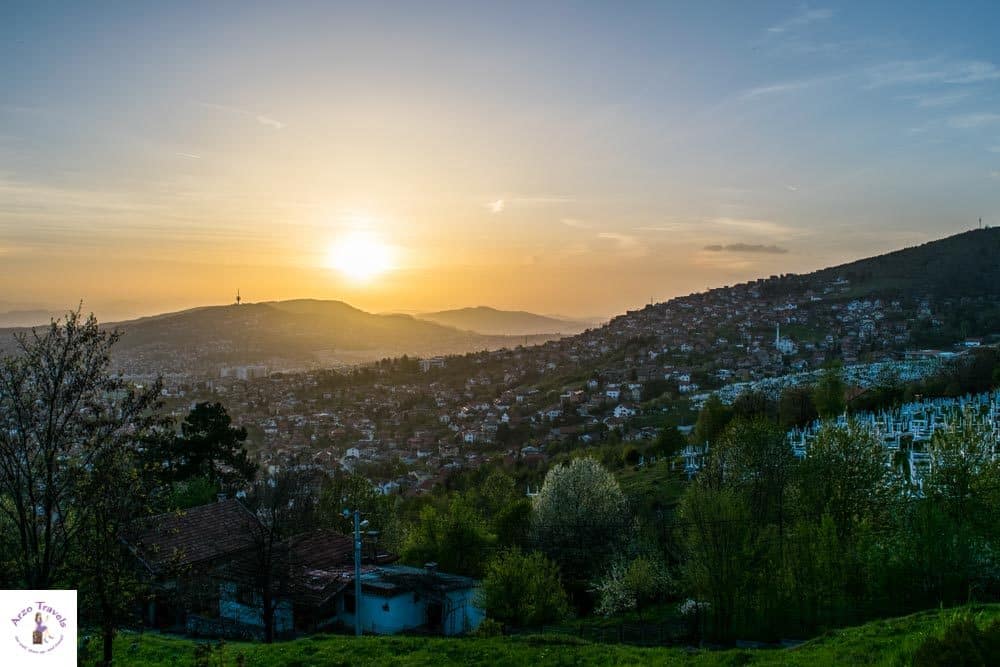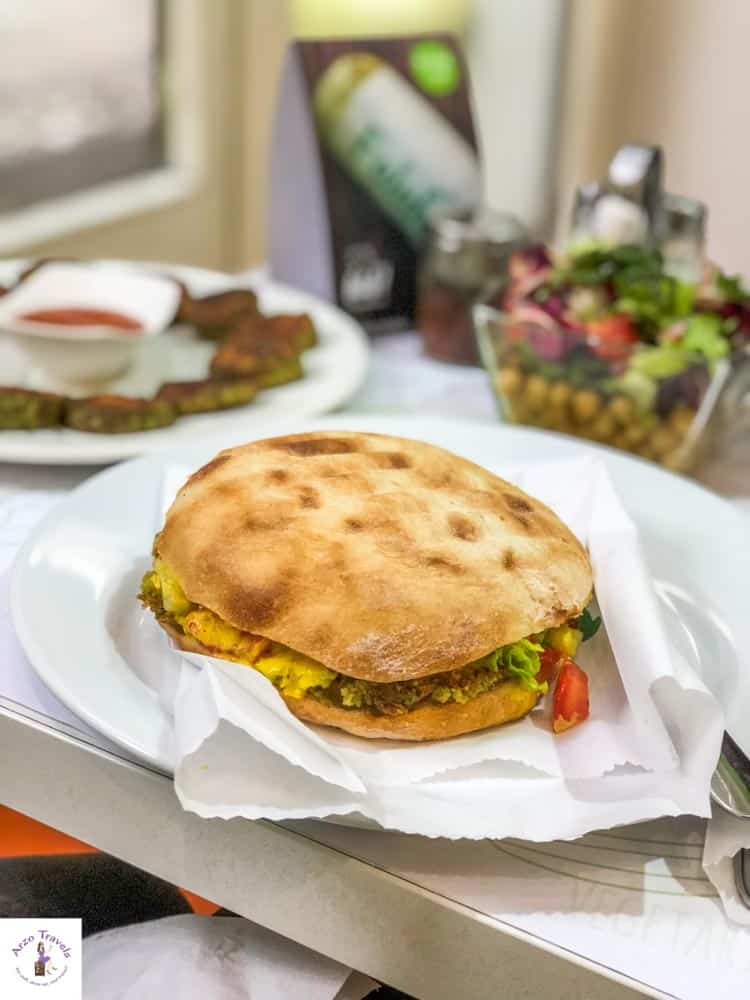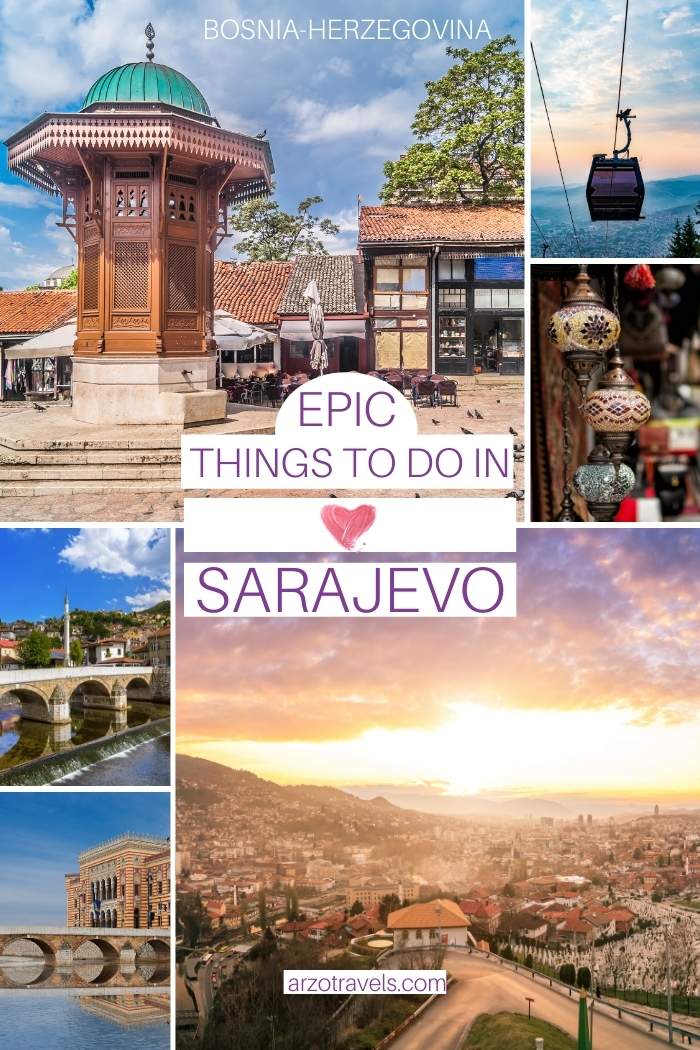ONE OR TWO DAYS IN SARAJEVO – ITINERARY
Are you planning your Sarajevo itinerary and wondering about the best things to do in Sarajevo in 2 days? Great choice. Sarajevo is amazing and exceeded all my expectations, and I am happy to share my travel tips with you. Here are the answers to your question on what to do in Sarajevo in one or two days.
To be honest, I never had Sarajevo on my radar. I visited, more or less, only because I was in Bosnia and visited Mostar already and thought it wouldn‘t hurt… Sarajevo quickly became one of my favorite cities in Europe. It is fun, friendly, and exciting. So, when you plan your Sarajevo itinerary, this post will help you find out about the best things to do in Sarajevo and how to plan your days.
Though this is not a typical itinerary, I structured the post around the best Sarajevo attractions so that you can easily plan your days – whether you stay one day, two days, three days, or even longer in Sarajevo. Sarajevo became the capital of independent Bosnia-Herzegovina (BiH, for short) in 1992 and was created by the Ottomans in the 15th century. If you walk through Sarajevo, you will quickly see the Turkish influence here. And it surely had an Istanbul vibe here – though it is much, much smaller.
Disclaimer: This post contains affiliate links. This means I might earn a small commission when you buy a product (at no extra cost to you) after clicking on my link. More about it here.
SARAJEVO ITINERARY
Okay, let´s get started with the most beautiful places to visit, Sarajevo, and the top things to do.
DAY 1 IN SARAJEVO
Start your trip with a Sarajevo walking tour (if possible).
Sarajevo Walking Tours
One of the first things to do is join a walking tour. There is one tour at 10 am at one at 4:30 pm.
Walking tours can help you understand the city, its people, history, and more in a much better way than if you learned it on your own. You can do free walking tours in Sarajevo or do a walking tour that is not free. There are different free tours – I did two of them.One focuses on the recent history (including the Sarajevo siege in the ’90s and life during that time), and one is a general walking tour that covers more of the city (how it developed, the Ottoman Empire, the Austrian-Hungary Empire, and how they both shaped and influenced the country). Both are interesting and if you are in Sarajevo for two or three days, I recommend taking both tours.
- If you do the walking tours, you will see some of the main places in Sarajevo. So, I suggest doing them at the beginning of your Sarajevo trip.
- Those tours are free, though I always recommend tipping. How much? It depends on how much you liked it (also, I base it on how many people take part – I tip more if there are only 2-3 people).
- Please check this site for updated information.
Old Town / Sarajevo Baščaršija
One of the main places to visit in Sarajevo is the old town. You will feel like you are in Istanbul or a Turkish city rather than in Eastern Europe. Baščaršija is the old part of Sarajevo, dating back to the Middle Ages. Drinking coffee and sitting with friends are deeply rooted in the culture here, and the locals spend a lot of time in the old town. According to my guide, this is also why prices here are fair (same prices for locals as for visitors). There are no tourist traps, and the food is good.
But you´ll also find many shops selling arts and crafts, souvenirs, jewelry, but also Western brand products. If you buy souvenirs, you might have to haggle a bit. I mean, this is also in their culture. But as for food and drinks, you don’t have to worry about being ripped off.
Apart from getting lost in the streets of the old town (for me, it meant literally getting lost since it is a small area but feels like a labyrinth, and even after five days, I did not really get the hang of it), there is not much more to do here.
Special places to visit in the old town are Baščaršija Square and Sebilj Fountain.
Sebilj Fountain is a wooden fountain located in the marketplace of Old Town’s bazaar at Baščaršija Square. It was built in the 18th century and still provides fresh drinking water today.
However, even if you come here early in the morning, you will always have to share the place with the local pigeons (you can even buy food and feed the pigeons, though this is probably not a good idea). Tip: When school ends, all the kids come to this place – making it even busier. If you want to avoid the biggest crowds, come before lunchtime.- But there is also the Gazi Husrev-beg Mosque which is the largest in Bosnia and Herzegovina and an important center for the country’s Islamic community.
- There is the Baščaršija Mosque, too, which was built in the 15th century. You can visit the mosque, and while you do not have to wear a scarf, you should take care to cover your shoulders and legs.
- Then there is the Morića Han, an inn that you can visit, with a history that stretches back to the 16th century.
Roses of Sarajevo
One of the things you will see in Sarajevo, even if you are not looking for them, are the Roses of Sarajevo.
It is a memorial to remember the people who died in mortal shell explosions during the war, from 1992 to 1995, carried out by the Army of Republics Srpska. Those roses are exactly where the people died, and the concrete scar was filled in with red resin. There are about 200 roses throughout the city, and the attack with the highest number of casualties happened at Markale Market.East and West Meeting Spot
When you leave the old town and head to the modern shopping street, you will find the “Where East and West Meet“ spot. If there are not any other people standing around, you might miss it!
It is the place where East and West collide and connect. As you stand on this spot and turn to face west, your photograph’s background will show “Eastern” or Ottoman Sarajevo. And if you turn 180° to face east, you’ll have the main walking area in the center of town, Ferhadija, behind you, which is home to some Austrian-Hungarian architecture.
Eternal Flame
From there, you just need to keep walking for another few minutes to reach the Eternal Flame.
The Eternal Flame memorial is dedicated to those who died during WWII – when the country was invaded and occupied by the Nazis and the fascist independent state of Croatia for four years.Miljacka River
From the Eternal Flame, you can head to the Miljacka River. The river flows through Sarajevo, dividing the city into southern and northern sides. However, as much as I like Sarajevo, I named it the world´s ugliest river. Though this might be an exaggeration, it just takes time to get used to its dark brown color. You will see more of the lake in the picture below- keep an eye out for the paragraph about the Yellow Fort.
Latin Bridge
The Latin Bridge is conveniently located near the old town, and it just takes a few minutes to get there! It should not be missed on any Sarajevo itinerary – because here is where WWI started – more or less.
The Latin Bridge is an Ottoman bridge over the river Miljacka in Sarajevo and it is where the Bosnian Gavrilo Princip killed the Archduke of Austria-Este: Franz Ferdinand and his wife (at that time, Sarajevo was ruled by Austria-Hungary) were driving down the street when they were assassinated at this bridge.
This assassination became the trigger point for World War I – the rest is history. It definitely is one of the main Sarajevo attractions. There is also a museum near the bridge – the Sarajevo Museum 1878 – 1918. Even though it is a small museum you could add it also to your itinerary.
Vijećnica / City Hall
From the Latin Bridge, it is just another few minute’s walk to reach the City Hall.
This building (which is a perfect example of Austrian-Hungarian architecture) was bombed in 1992. It was, and is, the National and University Library of BiH. Most of the books were destroyed by the bombing of the Bosnian Serbs, but the building was completely rebuilt, and you can now visit it.House of Spite – Inat Kuca
Opposite City Hall, you will find a house that is now a restaurant – the House of Spite house symbolizes the stubbornness of Bosnians today.
It used to be in a spot where the City Hall is now. The Austrian-Hungarian monarchy wanted to build the town hall at that location, but the house owner wasn’t willing to sell/leave his house. Eventually, the Austrian-Hungarians and this man agreed: His house was moved, brick by brick, over the Miljacka River. It directly faces the new City Hall, and the House of Spite (Inat Kuća) is now a restaurant.If you have not done any walking tours but followed this itinerary (and had lunch in between), then it might be time to plan the rest of your first day. You are near the old town now and can either have an early dinner or eat after the following two activities.
Kovači Martyr’s Cemetery
Just behind the old town (also in other parts of the city) are a few cemeteries. Not all cemeteries are for victims of the war, but when you head to the Yellow Fortress (more on that in a bit), you will find the Kovači Cemetery.
This cemetery, with its sea of white pillar-shaped headstones, really stands out. Even if you do not want to visit (which is totally understandable), you might wonder what it is because you will see them from different perspectives throughout your visit.Yellow Fort
For great views, I have several suggestions. If you visit the above-mentioned cemetery, it takes another 3 minutes of uphill walking (so maybe a ten-minute, steep, uphill walk in total) to arrive at the walls of Yellow Fortress (Žuta Tabija).
The fortress itself is not that stunning, but you have great views.
- You do not need to pay to enter the fortress and can enjoy the views from 8 am until midnight.
You can have a drink at a cafe – watching the sunset from there is pretty great and a fun (almost) free thing to do.
More religious places for the first day: If you would like to visit more religious sites, you will be pleased to find that Sarajevo is home to mosques, churches (Catholic and Orthodox), and synagogues that you can visit, which are all in and close to the old town. You are within minutes of all kinds of religious places.
Here are some more places you can add to your itinerary:
- Ashkenazi Synagogue
- Cathedral of Jesus Sacred Heart
- Cathedral Church of the Nativity of the Theotokos
Sniper Alley
People in Sarajevo (mainly Muslims and Catholics, Orthodox, Jews, and other minorities) lived in the city while under the Bosnian Serbs’ fire – who sat in the hills surrounding Sarajevo.
In the old town and the city center of Sarajevo, you will see many signs of the war, such as houses that are still not fully restored and seem to be pocked by bullet holes. However, many of these holes are not actually from bullets but rather from mortar fragments. The houses with bullet holes are outside the old town, closer to the hills that were easy to reach via guns.At Sniper Alley, you can see sniper‘s houses in the hills and houses scarred by bullet holes. Locals named it Suicide Alley, as snipers would shoot almost immediately when someone walked along the streets – even at kids and women.
If you do the walking tour, you will receive explanations here. Visiting the alley was extremely touching to me. However, with less than two days in Sarajevo – or if you want to focus on the positive side of Sarajevo – it is not a place that must be on your Sarajevo itinerary.
Vidikovac
Saving the best for last: Whether you have one day or more, my tip is to visit the Vidikovac and end your day at the restaurant there.
Not for the food (which was average), but because sitting at the outdoor restaurant and overlooking Sarajevo – while the sun goes down.
The restaurant is more elaborate than the cafe at the Yellow Fortress, and it is not well-known among visitors (I got this tip from the receptionist). The restaurant is busy and popular among locals. Food is very affordable, and you will get big portions for just a little money (service is slow, though). It is a great place to see on a sunny day.
You can either hike up (which should take about 45 minutes from the old town, though it is uphill and steep) or take a taxi. A taxi ride from the old town costs a few Euros and it is not only a taxi ride but also a wild roller coaster ride (at least, that was it in my case).
I hiked down (yes, in the dark) as I could not bother to call a taxi to pick me up again. You can also drive up there yourself (free parking spots available), but I am not sure the streets there are made to be driven by non-locals. It is seriously a bit crazy driving there, but if you have nerves of steel, why not?
DAY 2 IN SARAJEVO
Day 2 – If you use this post as an itinerary, this is the second day in Sarajevo.
Sarajevo Tunnel of Hope
If you have 2 days in Sarajevo and want to learn more about the war’s history, then visit the Tunnel of Hope. When Sarajevo was besieged during the war, this was the only access Sarajevo had to the rest of the world.
The 800-meter-long tunnel was used to deliver medicine, food, and artillery, which helped the locals survive and the army fights during the siege. It took more than six months to dig the tunnel and was done using pickaxes and shovels.
- It is located just outside of the city center (12 km), and you will need to get there via car, an organized tour, taxi, or public transportation.
- The entrance is about 5€ (without a tour), and you can walk 800 meters of the tunnel and visit the museum. But if you are not familiar with the history, it might be easier for you to join a guided tour.
- Check out their website here.
Srebrenica Gallery
After your time in the Tunnel of Hope, you have several more options for spending the day.
This next activity is not only for rainy days – you can visit the Srebrenica Gallery at any time of the year or in any weather. An army of Bosnian Serbs killed over 8,000 Muslim men and boys over the course of three days in the United Nations’ “safe area“ – Srebrenica, which lies in the east of Bosnia. More than 100,000 people died during the (nearly) four years of the Bosnian War. Srebrenica became one of the most prominent places of the war.
This genocide is the worst in Europe since World War II. Gallery 11/07/05 plays educational films on a loop about Srebrenica and the Sarajevo siege.
Wilson‘s Promenade and Visit Tito Café
Wilson’s Promenade – Sarajevo’s most popular walking area – is approximately two kilometers long and runs along the right bank of the Miljacka River. It is lovely to see another side of the city. You’ll notice that this place is visited mostly by locals.
Though I did not visit Tito Cafe, I enjoyed this different side of Sarajevo and got to see the golden can of beef. This is a monument that stands as an ironic thank you to the UN for the food they delivered during the war. As my guide told me, the people were incredibly thankful for the food deliveries, and it was not meant as an ungrateful gesture, but more of irony as the food was terrible.
White Fortress
Here are more tips for great views. The White Fortress is located slightly higher than the Yellow Fortress and takes a bit more effort to reach.
It took me probably about 25-35 minutes, and though the fortress itself is closed for renovations at the moment, the views were great – especially as you get to have views to the other side, which is quieter and perfect for nature lovers. At the fortress itself, you cannot do much. So, if you are short on time, the Yellow Fortress is probably the better choice because you can sit down and relax more.
However, from there, it is also not far from the Yellow Fortress so you can combine them.
Mount Trebević
Apparently, from Mount Trebevic, you have great views of Sarajevo – when I visited, it was foggy and rainy, so I did not get to enjoy the views.
- However, you can combine it with either a hike up (should take about 60-120 minutes) or use the cable cars in Sarajevo to take you up (for around 10€, round trip).
- You can even drive up to the very top (there are free parking spots available).
Sarajevo’s Abandoned Bobsled Track
If you are at Mount Trebevic, add the abandoned bobsled track to your list. I would not say it is a must-see in Sarajevo if you are only in Sarajevo for one day. Still, if you are in the city for two or three days, you can definitely add it – especially because you can easily combine it with a hike/drive up to Mount Trebevic.
Sarajevo hosted the ’84 Winter Olympics, and you can visit the bobsled and luge track, which still stands (in most parts) at the top of Mount Trebević Sarajevo. There is no entrance fee, and you can visit and walk along the luge track comfortably, which is now full of graffiti.
I was warned by locals that this side of the city (locals were not sure if it is still in Sarajevo or if it actually is in East Sarajevo, which is part of the Republic of Srpska) is not as safe as Sarajevo itself. So, I got the tip to visit on a sunny day when many other people will be around – robbery there is more common, and more people around will make robbery less likely. So, my tip is to not hike up – especially as a solo traveler – on a rainy/grey day when you would be the only person up there.
TRAVEL TIPS FOR YOUR SARAJEVO ITINERARY
I am sure you are well set with all the information on what to do and see in Sarajevo – now it is time for some quick travel tips.
How to Get to Sarajevo
- By plane: Sarajevo has an airport that is 12 km from the city center. From there, you can use a bus (the cheapest option) to get to Basarsija – the old town center. The buses run according to the flight schedules. Taxis should be around 10€ to the city center.
- By bus: There are two bus stations, and you can get to Sarajevo by bus from places like Banja Luka, Belgrade (Serbia), and many other cities in BiH.
- By car: Sarajevo is located in the central part of Bosnia and Herzegovina and is linked to the transversal of the two most important main routes: the Adriatic highway and by car – via Zagreb – Belgrade.
- By train: The main train station is a 10-minute walk from the center of town. From there, you can easily get to the old town via public transportation (the train ride from Mostar to Sarajevo is supposed to be very scenic, as was my car drive).
Driving into Sarajevo was quite pleasant (although I arrived during rush hour), but driving in Sarajevo itself was kind of a nightmare. The streets are extremely narrow, and parking in the old town is impossible. But once you have arrived in Sarajevo, ditch your car and get around on foot (more on that later).
How to Get Around Sarajevo
I arrived in Sarajevo by car but left it outside the city center and mostly walked. I rarely used the car (just once when I left the city and stopped at the mountain) and used a taxi only once.
- Most of the places I mention here, and the main Sarajevo landmarks, are located in the city center, and it is easy to walk around.
- But you can use public transportation (buses, trams, trolleybuses, and minibus lines). One ride costs a bit less than 1€, and you can buy tickets from the driver (or at a kiosk, which is also a few cents cheaper). Don´t forget to punch your ticket to avoid being fined.
- There is also a sightseeing bus tour (hop on and hop off) that shows you around Sarajevo.
- Taxis are quite cheap. I used a taxi once to get up a mountain (more on that later), and it was a taxi ride and a rollercoaster ride in one. So, walking is the most relaxed way of getting around.
People / Language
- In Sarajevo, people speak Bosnian, Croatian, and Serbian. I was very pleased to find that many people speak basic English – even the older ones – and many speak English very well (some also speak German). If you speak English (assuming you do since you are reading this post), you will not have any problems communicating.
- The people in Bosnia-Herzegovina were some of the friendliest I have ever come across in my travels. And Sarajevo holds a special place in my heart – the people are kind and open.
- While the majority are Muslim, they practice a liberal form of religion that makes it easy for all people to feel welcome and enjoy a wonderful, liberal atmosphere.
- And though there is poverty in the country and in the city (you will see quite a few beggars, even some children), I never felt that people were trying to rip me off. They were very welcoming toward visitors and were happy to see foreigners (knowing what positive influence tourism can have on the country), but more likely because they are just nice and kind.
Where to Eat in Sarajevo
Food in Sarajevo reminds me pretty much of Turkish food – kebabs, baklava, and other Turkish-influenced dishes.
The only aspect missing here is the vegetarian food you can find in Turkey (e.g., bulgur). So, if you love eating animals, you will love it here. But even as a vegetarian (and vegan), there are some options – mostly falafel – and there are two restaurants/cafes with good vegan food.TIP for healthy and vegan food: Falafel House – Bravadziluk 32, Sarajevo
Where to Stay in Sarajevo
- Hotel Michele: I recommend this unique 4-star hotel located about 600 meters from the old town. The staff is amiable, and you have a place to park (which you probably won‘t have in a hotel directly in the old town). It is a bit of an uphill walk, but a great place to stay if you want to escape the craziness of the old town. Find out more about Hotel Michele and check out the rates.
Tips for Solo Female Travelers
Sarajevo is a pretty safe place to visit – just keep a few things in mind.
- However, always be aware of where you go and watch your valuables carefully (especially in the old town).
- Since I visited Sarajevo with my dog, I am unsure if I am really the right one to give this advice, but I felt safe and secure.
- I am always a bit cautious but did not feel that I needed to be more cautious than other European cities.
- The people are extremely friendly and open – many speak English, and it was not difficult to talk to locals.
Tips for Traveling With a Dog
In Sarajevo, Muslims are the majority. And while I am not religious, I know my folks, and let me tell you: Muslims normally don’t like dogs (and that’s a nice way of putting it). However, people in Sarajevo were crazy for Puppygak.
Maybe because he is small (and of course, overly cute) and you do not see that many dogs in the city center. Only about a quarter of the hotels and apartments allow dogs, and you cannot take dogs into many restaurants.
As long as the weather is good and you can sit outside, it should not be a big deal. In colder months or on rainy days, it is another story, though.
More Things to Know
- Smoking is very common – very common.
- Currency: Bosnia and Herzegovina’s currency is a convertible mark (KM). 2 KM is about 1.03 € (May 2024).
- Some bigger stores accept credit cards, but most hotels (especially the apartments), restaurants, cafes, etc., do not accept them. Cash is not only king here, but king and queen.
- Water: You can drink tap water and will find plenty of water fountains where you can refill your water bottles (especially near the mosques).
- Costs: Sarajevo is probably one of the cheapest capitals to visit in Europe. Food, accommodations, fuel, and activities… I can hardly think of any other capitals in Europe that offer so much for so little money. So, a vegetarian lunch including a drink is about 7€, and it’s not much more for a meat dish (of course, it depends on what exactly you order).
FINAL THOUGHTS ON THE BEST ACTIVITIES IN SARAJEVO
Sarajevo is a beautiful and fun city – compared to other European capitals, it is quite small, but there is plenty to do and see. Hopefully, this post has helped you find out about the best things to do in Sarajevo. It truly is different from most European cities, but so full of friendly, nice people and so much history and it surely is worth a visit.
Here is my itinerary for Bosnia-Herzegovina


